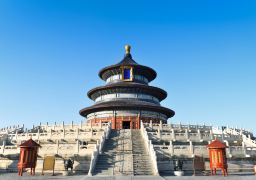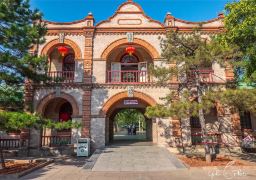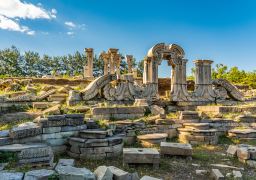The Ming Tombs, located at the southern foot of Tianshou Mountain in Changping District, Beijing, began construction with the Changling Tomb in May of the Yongle seventh year (1409 AD) and ended with the burial of the last Ming Emperor, Chongzhen, in the Siling Tomb. Over more than 230 years, 13 magnificent imperial tombs, 7 concubine tombs, and 1 eunuch tomb were built here. A total of 13 emperors, 23 empresses, 2 crown princes, and over 30 concubines and a eunuch were buried, making it the most complete and largest tomb complex with emperors buried in the world today.
The Ming Tombs are architecturally grand, complete in system, and have a long history, possessing high historical and cultural value. The Changling Tomb covers an area of about 120,000 square meters. Its layout is square in the front and circular in the back. The square part in the front is composed of three connected courtyards. The tomb gate of Changling faces north. Upon entering the gate, to the right, or the east side, there is a stele pavilion. The wooden structure houses a large stone stele with a unique design, featuring a dragon head protruding from the top of the stele; the stele base is a mythical creature with a dragon head and a turtle body covered in scales. Passing through the tomb gate and moving north, one encounters the Ling’en Gate. Beyond the Ling’en Gate, there is a divine silk burner on each side, with the majestic Ling’en Hall directly in front. The Ling’en Hall is the main hall of Changling, and its architectural style is consistent with the Hall of Supreme Harmony in the Forbidden City, using whole logs of golden nanmu wood for beams, columns, and rafters, with column diameters all over 1 meter, which are rare and excellent materials. Inside the hall, in the center, stands a tall bronze statue of the Ming Emperor Zhu Di, depicting his elderly image seated on a throne with a solemn expression. The hall also displays some unearthed artifacts from the Dingling Tomb, with many exhibition cabinets lining the walls. There are gold, silver, porcelain, jade, and other items for visitors to admire and see the belongings of the Ming emperors. Exiting the Ling’en Hall through the back door and continuing north, one reaches the Lingxing Gate, followed by the Five Offerings, and then the tall Ming Tower. The Ming Tower’s plaque prominently displays the word ‘Changling’. Each tomb in the Ming Tombs has a Ming Tower, and most are well preserved, which is related to their brick and stone structures being quite sturdy. Behind the Ming Tower is the treasure city, with the underground palace of the buried emperor and empress beneath the yellow soil. This marks the end of the tour, with Tianshou Mountain behind it. The entire site is open year-round from 08:30 to 18:00. Favorable policies: Children under 6 years old or under 1.2 meters in height enter for free. Active-duty military personnel and firefighters enter for free with valid identification (military security cards are not valid). Disabled persons (including military disabled) enter for free with a valid disability certificate or military disability certificate. Retired personnel enter for free with a retirement certificate. Elderly over 60 years old enter for free with valid identification. Beijing Tong—Elderly and Disabled Assistance Card holders enter with a formal card; those with a temporary card must also show their ID card. Students aged 6 to 18 and full-time university undergraduates and below (excluding adult education) enter at half price with valid identification. Youth from Hong Kong, Macao, and Taiwan enter at half price with a valid travel permit between Hong Kong and the mainland, a travel permit between Taiwan and the mainland, or a student ID. Social security recipients enter at half price with a valid social security benefit certificate. Additional notes: The above information is for reference only. Please check the day’s disclosures from the Beijing Ming Tombs scenic area for specific details.A must-visit tip: There is a Ming Chang Tomb Restaurant within the scenic area where you can dine, with an average cost of about 100 yuan per person. The restaurant operates until around 2 or 3 in the afternoon.









